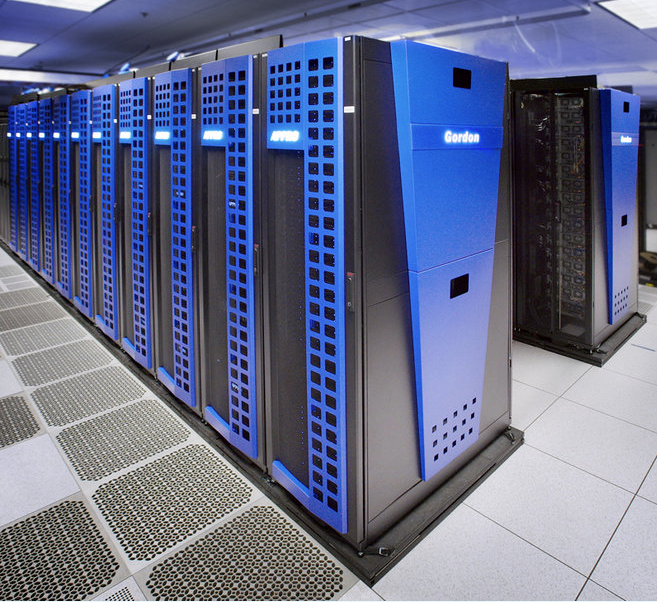The worlds first flash based supercomputer has been unveiled at the San Diego Supercomputer Center. Aptly named “Gordon” (i.e. Flash Gordon), this new supercomputer is an impressive display of how SSD technology is presenting itself not only in consumer devices, but in enterprise environments as well.
Supercomputers have traditionally relied upon mass amounts of hard disk drives to handle their data storage and access. Flash Gordon is different, however.
Gordon can access data faster than any other computer created; an incredible 9 times faster than the previous supercomputer world record holder in fact. How fast might that be? Try 36,000,000 IOPS or thirty six million Input/Output Operations Per Second, all constructed for a paltry 20 million dollars.
 These types of speeds can be obtained by using 1,024 Intel 710 SSD drives, packing a whopping 300TB of Intel eMLC flash. There are also 1,024 dual-socket nodes, each with Intels new 22nm Sandy Bridge Xeon E5 CPUs, and also 64GB of DDR3 memory for each of these nodes.
These types of speeds can be obtained by using 1,024 Intel 710 SSD drives, packing a whopping 300TB of Intel eMLC flash. There are also 1,024 dual-socket nodes, each with Intels new 22nm Sandy Bridge Xeon E5 CPUs, and also 64GB of DDR3 memory for each of these nodes.
 This type of architecture lends itself to some extreme performance, with performance measured at 280 Teraflops. This isn’t exactly the fastest computational speed from a supercomputer, it actually ranks in at #48 in the top 500 in that regard. The big story here is the I/O speed that this beast can muster, fast enough to download 220 full length HD movies per second. For just plain data storage, the supercomputer packs 4 Petabytes of hard disk drives, so there should be plenty of room for all of the data imaginable.
This type of architecture lends itself to some extreme performance, with performance measured at 280 Teraflops. This isn’t exactly the fastest computational speed from a supercomputer, it actually ranks in at #48 in the top 500 in that regard. The big story here is the I/O speed that this beast can muster, fast enough to download 220 full length HD movies per second. For just plain data storage, the supercomputer packs 4 Petabytes of hard disk drives, so there should be plenty of room for all of the data imaginable.
It would take 1,900 years to listen to just 1 petabyte of MP3 music. There is also 64 Terabytes of DDR3 RAM under the hood just to keep things cooking along. This type solid state drive use highlights present day shift in supercomputing and data storage. It is surprising that we have yet to hear of similar SSD supercomputers replacing spindle based systems of yesterday.
 The capability to store large vast amounts of data has been around for some time and is accomplished merely by scaling hard disk drive or tape storage. This supercomputer can store every single movie in the Netflix library 3 times over, and still have room for roughly a quarter of a million more movies!
The capability to store large vast amounts of data has been around for some time and is accomplished merely by scaling hard disk drive or tape storage. This supercomputer can store every single movie in the Netflix library 3 times over, and still have room for roughly a quarter of a million more movies!
The real challenge isn’t the storage of the data; it is being able to access that data fast enough so that it can be analyzed and ‘mined’ efficiently. There isn’t much sense in having a 280 Teraflop capable machine if it is waiting on data. These types of data storage advances in the supercomputing realm are going to help usher in new capabilities, and it surely will not be long until the supercomputer at the #1 spot is an SSD based machine!
 The SSD Review The Worlds Dedicated SSD Education and Review Resource |
The SSD Review The Worlds Dedicated SSD Education and Review Resource | 